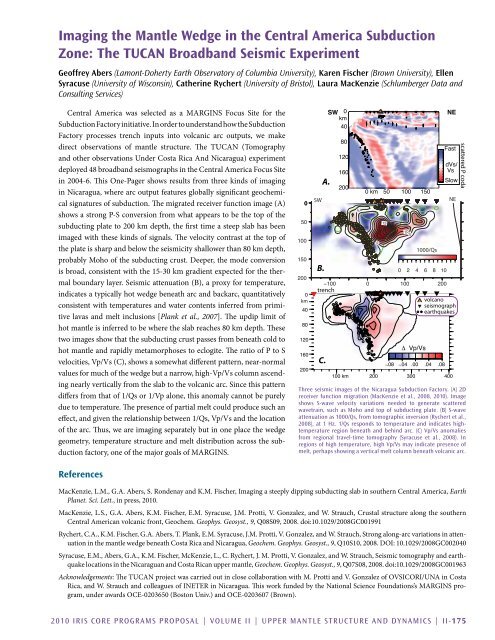Download Volume II Accomplisments (28 Mb pdf). - IRIS
Download Volume II Accomplisments (28 Mb pdf). - IRIS
Download Volume II Accomplisments (28 Mb pdf). - IRIS
You also want an ePaper? Increase the reach of your titles
YUMPU automatically turns print PDFs into web optimized ePapers that Google loves.
Imaging the Mantle Wedge in the Central America Subduction<br />
Zone: The TUCAN Broadband Seismic Experiment<br />
Geoffrey Abers (Lamont-Doherty Earth Observatory of Columbia University), Karen Fischer (Brown University), Ellen<br />
Syracuse (University of Wisconsin), Catherine Rychert (University of Bristol), Laura MacKenzie (Schlumberger Data and<br />
Consulting Services)<br />
Central America was selected as a MARGINS Focus Site for the<br />
Subduction Factory initiative. In order to understand how the Subduction<br />
Factory processes trench inputs into volcanic arc outputs, we make<br />
direct observations of mantle structure. The TUCAN (Tomography<br />
and other observations Under Costa Rica And Nicaragua) experiment<br />
deployed 48 broadband seismographs in the Central America Focus Site<br />
in 2004-6. This One-Pager shows results from three kinds of imaging<br />
in Nicaragua, where arc output features globally significant geochemical<br />
signatures of subduction. The migrated receiver function image (A)<br />
shows a strong P-S conversion from what appears to be the top of the<br />
subducting plate to 200 km depth, the first time a steep slab has been<br />
imaged with these kinds of signals. The velocity contrast at the top of<br />
the plate is sharp and below the seismicity shallower than 80 km depth,<br />
probably Moho of the subducting crust. Deeper, the mode conversion<br />
is broad, consistent with the 15-30 km gradient expected for the thermal<br />
boundary layer. Seismic attenuation (B), a proxy for temperature,<br />
indicates a typically hot wedge beneath arc and backarc, quantitatively<br />
consistent with temperatures and water contents inferred from primitive<br />
lavas and melt inclusions [Plank et al., 2007]. The updip limit of<br />
hot mantle is inferred to be where the slab reaches 80 km depth. These<br />
two images show that the subducting crust passes from beneath cold to<br />
hot mantle and rapidly metamorphoses to eclogite. The ratio of P to S<br />
velocities, Vp/Vs (C), shows a somewhat different pattern, near-normal<br />
values for much of the wedge but a narrow, high-Vp/Vs column ascending<br />
nearly vertically from the slab to the volcanic arc. Since this pattern<br />
differs from that of 1/Qs or 1/Vp alone, this anomaly cannot be purely<br />
due to temperature. The presence of partial melt could produce such an<br />
effect, and given the relationship between 1/Qs, Vp/Vs and the location<br />
of the arc. Thus, we are imaging separately but in one place the wedge<br />
geometry, temperature structure and melt distribution across the subduction<br />
factory, one of the major goals of MARGINS.<br />
0<br />
50<br />
100<br />
150<br />
200<br />
0<br />
km<br />
40<br />
80<br />
120<br />
160<br />
200<br />
SW<br />
B.<br />
A.<br />
SW 0<br />
km<br />
40<br />
80<br />
120<br />
160<br />
200<br />
5<br />
0 km 50 100 150<br />
5<br />
15<br />
10<br />
5<br />
1000/Qs<br />
0 2 4 6 8 10<br />
NE<br />
Fast<br />
dVs/<br />
Vs<br />
Slow<br />
−100 0 100 200<br />
trench<br />
volcano<br />
seismograph<br />
earthquakes<br />
C.<br />
Δ Vp/Vs<br />
−.08 −.04 .00 .04 .08<br />
100 km 200 300 400<br />
Three seismic images of the Nicaragua Subduction Factory. (A) 2D<br />
receiver function migration (MacKenzie et al., 2008, 2010). Image<br />
shows S-wave velocity variations needed to generate scattered<br />
wavetrain, such as Moho and top of subducting plate. (B) S-wave<br />
attenuation as 1000/Qs, from tomographic inversion (Rychert et al.,<br />
2008), at 1 Hz. 1/Qs responds to temperature and indicates hightemperature<br />
region beneath and behind arc. (C) Vp/Vs anomalies<br />
from regional travel-time tomography (Syracuse et al., 2008). In<br />
regions of high temperature, high Vp/Vs may indicate presence of<br />
melt, perhaps showing a vertical melt column beneath volcanic arc.<br />
NE<br />
scattered P coda<br />
References<br />
MacKenzie, L.M., G.A. Abers, S. Rondenay and K.M. Fischer, Imaging a steeply dipping subducting slab in southern Central America, Earth<br />
Planet. Sci. Lett., in press, 2010.<br />
MacKenzie, L.S., G.A. Abers, K.M. Fischer, E.M. Syracuse, J.M. Protti, V. Gonzalez, and W. Strauch, Crustal structure along the southern<br />
Central American volcanic front, Geochem. Geophys. Geosyst., 9, Q08S09, 2008. doi:10.1029/2008GC001991<br />
Rychert, C.A., K.M. Fischer, G.A. Abers, T. Plank, E.M. Syracuse, J.M. Protti, V. Gonzalez, and W. Strauch, Strong along-arc variations in attenuation<br />
in the mantle wedge beneath Costa Rica and Nicaragua, Geochem. Geophys. Geosyst., 9, Q10S10, 2008. DOI: 10.1029/2008GC002040<br />
Syracuse, E.M., Abers, G.A., K.M. Fischer, McKenzie, L., C. Rychert, J. M. Protti, V. Gonzalez, and W. Strauch, Seismic tomography and earthquake<br />
locations in the Nicaraguan and Costa Rican upper mantle, Geochem. Geophys. Geosyst., 9, Q07S08, 2008. doi:10.1029/2008GC001963<br />
Acknowledgements: The TUCAN project was carried out in close collaboration with M. Protti and V. Gonzalez of OVSICORI/UNA in Costa<br />
Rica, and W. Strauch and colleagues of INETER in Nicaragua. This work funded by the National Science Foundations’s MARGINS program,<br />
under awards OCE-0203650 (Boston Univ.) and OCE-0203607 (Brown).<br />
2010 <strong>IRIS</strong> Core Programs Proposal | <strong>Volume</strong> <strong>II</strong> | Upper Mantle Structure and Dynamics | <strong>II</strong>-175
















